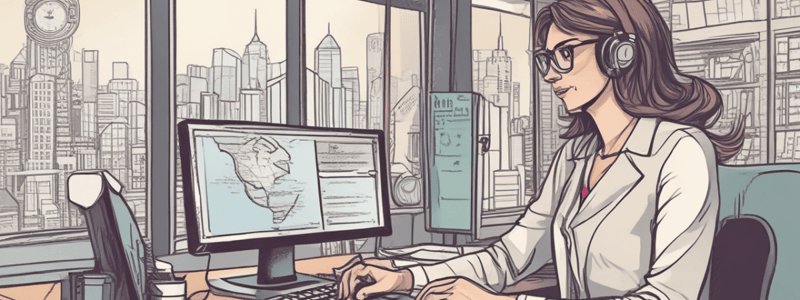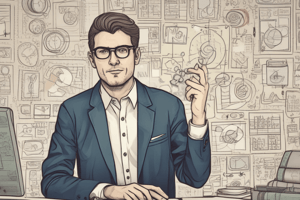Podcast
Questions and Answers
What is one of the key components of competence in delivering a service?
What is one of the key components of competence in delivering a service?
- Treating customers rudely
- Providing incorrect advice
- Following procedure and implementing customer instructions correctly (correct)
- Having a long waiting time
Customers expect service staff to be slow and inefficient.
Customers expect service staff to be slow and inefficient.
False (B)
What is one way to delight customers through care?
What is one way to delight customers through care?
Treating customers with sympathy and patience
Customers hope that the service, staff, and products will be __________ to them.
Customers hope that the service, staff, and products will be __________ to them.
What is one way to delight customers through friendliness?
What is one way to delight customers through friendliness?
Customers are dissatisfied if their choice is not available.
Customers are dissatisfied if their choice is not available.
What is one way to delight customers through attentiveness?
What is one way to delight customers through attentiveness?
Match the following service factors with their descriptions:
Match the following service factors with their descriptions:
Organizations must invest in these factors if they want to __________ customers.
Organizations must invest in these factors if they want to __________ customers.
Customers expect service staff to know their product or service and the advice they are given to be correct.
Customers expect service staff to know their product or service and the advice they are given to be correct.
Flashcards are hidden until you start studying
Study Notes
Defining the Customer
- A customer is someone who purchases a good or service for themselves or others.
- They can make one or more purchases.
- Loyal customers are more likely to purchase from certain brands or stores, while others shop around.
- A successful business knows its customers to meet their needs and anticipate their expectations.
- Market research is essential to understand the customer base and their needs.
Customer vs Consumer vs Client
- A customer is the purchaser of a good or service.
- A consumer is the user of a good or service (not always the customer).
- Marketing often targets consumers, not customers.
- Businesses should target both customers and consumers for successful marketing.
- Clients are used in business-to-business (B2B) transactions and service organizations (e.g., legal, healthcare, consulting).
Internal Customer
- An external customer pays for a service and can switch providers if unhappy.
- An internal customer is within an organization, receives services from colleagues, and has no choice in changing providers.
- Examples of internal customers include individuals receiving services from colleagues and franchisees/business partners distributing goods/services to external customers.
- Dissatisfied internal customers can affect external customers, leading to negative outcomes.
The Customer Relationship
- A customer relationship is built over time through marketing, sales, technical help, customer service, and after-sales service.
- The goal is to create loyal customers who repeat business and bring in new customers.
- A successful organization prioritizes building loyal customers over one-time sales.
- Customer loyalty comes from individuals who feel a strong relationship with the organization.
- First impressions are crucial in building customer relationships.
Benefits of Good Customer Service
- Good customer service increases customer loyalty and repeat business.
- Loyal customers are more likely to refer others and spend more money.
- Poor customer service leads to lost sales, reduced customer loyalty, and negative word-of-mouth.
The Six Loyalty Stages
- Suspect: someone who might buy your product or service.
- Prospect: someone who needs your product/service and can afford it.
- First-Time Customer: someone who has made one purchase.
- Repeat Customer: someone who has made multiple purchases.
- Client: someone who buys from you regularly.
- Advocate: someone who buys from you regularly and recommends you to others.
Satisfying Customer Expectations
- Good customer service meets and exceeds customer expectations.
- Poor customer service negatively impacts profit margins.
- The RATER model (Reliability, Assurance, Tangibles, Empathy, Responsiveness) assesses service quality from the customer's perspective.
- Gap analysis identifies the difference between customer expectations and perceptions of a product/service.
Changing Customer Expectations
- Customer expectations are increasing in all RATER dimensions.
- Customers expect consistency, accuracy, and rapid responses.
- They also expect seamless communication across all channels.
- Businesses must continually improve service delivery standards to meet changing customer expectations.### Delighting Customers
- Delighting customers results from delivering service factors brilliantly, leading to customer satisfaction.
Factors that Delight Customers
- Friendliness: warm, approachable, positive attitude, and making the customer feel welcome.
- Commitment: demonstrating pride and satisfaction in helping the customer, going above and beyond the expected standard of delivery.
- Attentiveness/Helpfulness: demonstrating a commitment to work, being diligent and thorough, and helping the customer beyond expected standards.
Importance of Investing in Delight Factors
- Organizations must invest in these factors to delight customers.
Studying That Suits You
Use AI to generate personalized quizzes and flashcards to suit your learning preferences.




